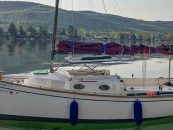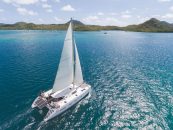Prior to Clipper Round the World Yacht Race, I had very limited sailing experience. I grew up near the Broadwater and my parents had a small boat when I was young. I used to love tripping around in it with my friends on the weekends. I had also done two trips sailing around the Whitsundays with friends, which we chartered ourselves. But these trips didn’t exactly prepare me for the rigours of ocean racing.
Growing up in Australia, I watched and admired the Sydney to Hobart Yacht Race. I always aspired to somehow be a part of this event, but I just didn’t know how I was going to do it. I decided to participate in the Clipper Round the World Yacht Race at a point in my life when I was working and commuting a lot. One night, I was coming home late and saw an advertisement for the Clipper Race on the train. It was a challenge that I couldn’t resist, so I sent off my application then and there.
The Prep
To participate, the Clipper Race requires you to complete four weeks of intensive training. If you’ve never been a part of ocean racing before, nothing can really prepare you for the extremes. It’s a steep learning curve as you learn to sail, as well as deal with the mental and physical toll it takes on you. The first week of training and our first overnight sail during that week was a bit of a shock to the system. But I loved the challenge and it made me to want to learn more.
Aside from the technical elements of knowing what to do on the boat, I prepared myself by training with a personal trainer and trying to eat a varied diet before I left, as food on the boat can become limited in the longer legs. I also had to purchase the necessary personal equipment—consisting mainly of warm clothing and wet weather gear. And of course, I drew confidence from the love and support my loved ones provided in the lead-up to the race.
This might sound silly, but I wasn’t prepared for the extreme weather conditions we would face. So from that point of view, being a Gold Coaster was somewhat of a hindrance. We are too spoiled by year round beautiful weather! However, I’m quite fortunate that one of the Clipper Race’s main training facilities is in Sydney. Some people had to fly from all over the world just to complete their training. So living just a short flight away was certainly a benefit there.
In total, I was away for almost four months, including port stops between races. My portion of the race included two legs which was made up of five separate races:
- Albany to Sydney
- Sydney to Hobart
- Hobart to Airlie Beach
- Airlie Beach to Da Nang (Vietnam)
- Da Nang to Qingdao (China)
The base cost of getting a berth on the Clipper Race is broken down into price per leg, and you also need to cover the cost of the four weeks of compulsory training. The cost per leg, of which I did two legs (4 and 5), is roughly 5,000 GBP per leg, and the four weeks of training is about the same price. Therefore, for my two legs and the training, it cost me around 15,000 GBP. You can cover the cost in instalments as part of a payment plan over time. Included in the cost is all your food during the race and the standard Henri Lloyd foul weather gear, as well as your crew uniforms. On top of that, you have insurance, flights, accommodation during stopovers, etc.
You are assigned to a boat while you’re completing the training, the aim being to even out the abilities, ages and sexes evenly as possible. It’s quite a big deal. And considering your own personal goals, you hope that you’re assigned to a boat with a skipper and crew who align with your reasons for doing the race.
You complete the fourth training week after crew allocation which allows you to train with some of your crew and skipper.
On board Visit Seattle
Visit Seattle operated on a two-watch system, which was made up of four- to six-hour watches. While on watch, you are responsible for all on-deck and down-below duties. Your time off watch is spent catching up on as much sleep as you can to recover. However, that doesn’t mean you won’t be woken in the middle of your off-watch sleep to go up to the bow change a sail and then throw yourself back into your bunk, dripping wet, for another 30-minute sleep before you’re required to do it all over again!
We shared the on-deck roles as much as possible. However, my main role on the boat was as a bowman, which involved assisting in changing the head sails no matter what the conditions. This meant I got thrown around a fair bit and spent most of my time saturated from head to toe. In the later part of my race, I was lucky enough to be asked to be an assistant watch leader, responsible for the crew on deck and maintaining the race strategy while the skipper was down below. It was also up to me and the other watch leaders to keep an eye on the wellbeing of the crew and make sure everyone was in good mental and physical health.
Aside from that role, all crew members were expected to help in the maintenance and cleaning of the boat. This included cleaning the heads, emptying the bilges, and disinfecting the surfaces down below every four hours. We also took turns doing ‘mother watch’, which meant feeding up to 20 hungry crew members for the day, and making endless cups of tea—accompanied, of course, with a soggy salty biscuit, or everyone’s favourite: chocolate!
Life changing?
I don’t believe in one event being a life-changing experience. Everything we go through in life changes us in some way. However, my highlight would be the Sydney to Hobart leg. It certainly lived up to expectations! For our crew, we were able to treat the Sydney to Hobart as a bit of a sprint race as we are generally at sea for weeks. So we really wanted to give this one everything we had. Being the only Australian on-board Visit Seattle, I was able to prepare my other crew members for the excitement of Boxing Day, and the hectic race start with all the other yachts on the harbour. The race start was such a thrill and the conclusion at the other end was a really tight finish between all of the Clipper 70 fleet. It was very exciting! The final morning of the Sydney to Hobart race was spent sailing downwind in spectacular weather conditions zig-zagging between each other and jostling for position.
I have certainty learned a lot about leadership, which I know will transition well into my profession. I also learned a lot about priorities in life and the value of great friends and family, and how lucky I am to have a supportive partner.
Back home
It’s been an ongoing adjustment to transition back into a more structured, and at times, mundane lifestyle. I spent the first week or so waking up in four-hour intervals and wondering why someone wasn’t reminding me I was needed up on deck. Much to my girlfriend’s disgust, normal isn’t quite as appealing as it used to be. I’m on the lookout for my next adventure!
The Clipper Race was a great experience and taught me everything I know about sailing. But I’d like to pursue other avenues for future ocean racing. I’m also hoping to complete my coastal skipper course so I can use my new-found skill for some more laid back holiday style sailing too.
Top three tips/advice for those who want to sail in general
If you suffer from sea sickness think twice before joining the race. I watched many of our crew suffering for the whole time we were at sea.
Where possible, stay warm and dry. Take special care to look after your hands and keep your feet dry.
Have an esky full of chocolate!
Tips/advice for those who want to join the Clipper Round the World Yacht Race?
Plan ahead where possible. It requires a large financial commitment, and significant amount of time out of your day-to-day life.
Be prepared that you may find the sailing element not to be the hardest part. You will need to be open-minded and tolerant of living with a range of people. You will be living in close proximity, and learning how to navigate and get the best out of everyone’s strengths and weaknesses.
By Luke Dernedde, Visit Seattle
Questions about the Clipper Race and ocean racing? Need an extra hand on your yacht? Contact Luke at lukedernedde@gmail.com.
ABOUT THE CLIPPER ROUND THE WORLD YACHT RACE: The first Clipper Round the World Yacht Race crew left Plymouth in October 1996 on board eight 60-foot yachts. (Today, they sail 70-foot yachts.) The Clipper Round the World is one of the biggest challenges of the natural world and an endurance test like no other. With no previous sailing experience necessary, it’s a record breaking 40,000 nautical mile race around the world on a 70-foot ocean racing yacht. All that is asked of participants is a good level of fitness, an age over 18, and a thirst for adventure into the unknown. It is the only race in the world where the organisers supply a fleet of twelve identical racing yachts, each with a fully qualified skipper to safely guide the crew.
Image courtesy Clipper Round The World



























